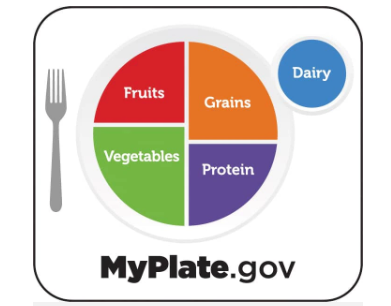Helping Your Child: Tips for Parents and Other Caregivers
Parents and other caregivers can guide children to develop lifestyle habits that will support their good health for years to come. We know that as a parent or caregiver you may not have all the answers. Like many Americans, you may even struggle to develop and stick with healthy habits of your own. One way to win this double struggle is to practice healthy lifestyle habits—together!
Consuming healthful foods and beverages, doing regular physical activity, getting adequate sleep, and other factors may help children to
grow
learn
build strong bones and muscles
maintain a healthy weight
reduce future chances of developing diabetes and heart disease
feel good about themselves

As a parent or caregiver, you play a big part in shaping children's eating and drinking habits. When you make it a habit to consume foods and beverages that are low in added sugars, saturated fat, and salt and are high in fiber, the children you care for may learn to like these foods as well. If a child you are caring for does not like a new food right away, don't be upset. Children often need to see a new food many times before they will try it.
Be a role model. As a parent or caregiver, you also have an effect on children's physical activity. You do not need to be an expert at any activity. Just get up, move, and show children how much fun being active can be. They may grow to like it too. You can set a good example by going for a walk or riding a bike instead of watching TV, playing a video game, or surfing the internet. Find an activity that you enjoy and can do together.
Talk about being healthy. As you learn more about how to improve your health, take the time to talk to your children about how a certain food or physical activity may help them. For example, when going for a walk, bring your children with you and let them pick the route. Discuss how walking helps you feel better and is a fun way to spend time together.
Use your children's food and beverage choices as teaching moments. Speak up when you see unhealthy choices. Direct children to healthier options or say, "You can have a little of that, but not too much." Talk to them about why an overly salty or heavily sugared snack is not the best choice. Avoid making them feel guilty about their food or beverage choices. You can also praise your children when they choose a healthy item like fruit.

Use comments like these
"Great choice!"
"You're giving your body what it needs with that snack!"
"I like those, too."
With physical activity, try upbeat phrases like these to keep your child excited
"You run so fast, I can hardly keep up!"
"You are building a strong, healthy heart!"
"Let's walk 10 more minutes to make us stronger."
Make sure your child gets enough sleep. Getting enough sleep can improve your child’s mental, emotional, and physical health. Not getting enough sleep may lead to many health issues, including obesity. Find out how many sleep hours experts recommend for your child External link, depending on his or her age.
Believe in the power to change. Know that eating healthy and moving more are the building blocks to better health. Work together to form healthy habits.
Promote good health beyond your family. Other adults may play a role in your child's life, too. You can share ideas about healthy habits with them. For instance, many parents and caregivers work outside the home and need others to help with childcare. Family members, day care providers, babysitters, or friends may shape your child's health habits. Talk to them to make sure they offer healthy meals, snacks, and drinks. Check that caregivers are also providing plenty of active playtime and limiting inactive time spent with TV, video games, or other devices.
If your child is in school, you can help promote healthy habits in several other ways
Find out more about the school's breakfast and lunch programs.
Find out about the school’s physical education program, and look for opportunities to be active during the school day.

Consider other influences. Just as they do for you, your children's friends and the media can also affect healthy choices.
Some TV, online, and other ads try to persuade children to consume high-fat foods and sugary drinks. You can help your children be aware of these pressures. Speak with your children about choices while you watch TV, surf the internet, or go to the movies with them. Talk about how media outlets and influencers sell products or convey values through famous athletes, child celebrities, cartoon and action figures, and made-up images. Use programs and ads to spark chats about your values. These talks may help your child make healthy choices outside the home.
Just like adults, children need to consume foods and beverages that are packed with nutrients. Also, like adults, children should consume just enough calories to fuel their daily living and activities. The Dietary Guidelines for Americans, 2020–2025 External link suggest balancing calories you consume with physical activity. The guidelines also recommend improving eating habits to promote health, reduce the risk of disease, and reduce overweight and obesity. Americans ages 2 years and older are encouraged to consume a variety of healthy foods and beverages. Suggested items include
fruits, vegetables, unsalted nuts and seeds (please make sure your child can tolerate these foods and isn’t allergic to them), and whole grains
fat-free or low-fat dairy products, including milk, yogurt, cheese, and/or fortified nondairy beverages
a variety of protein foods, including seafood, lean meats and poultry, eggs, legumes (beans and peas), nuts, seeds, and soy products
What foods and beverages should be limited?
Youth and adults are also encouraged to get less
refined grains
added sugars
saturated fats, such as lard, butter, and margarine, which are often solid at room temperature
salt (sodium)
Added sugars, solid fats, and salt often occur in pizzas, chips, crackers, sodas, sugar-sweetened drinks, desserts like cookies or cake, and fast foods. If children and teens consume these foods and beverages, these items should be limited on a healthy eating plan.
Another step is to make sure your children have breakfast to spark the energy they need to focus in school. Some studies suggest that eating breakfast regularly may decrease children’s chances of developing obesity.1
Make sure your children eat a healthy breakfast to spark the energy they need to focus in school.
How can I help my child eat better?
Use less fat, salt, and sugar. Here are some ideas to help you and your child follow a healthy eating plan
Cook with fewer solid fats. Use olive or canola oil instead of butter or margarine. Bake or roast foods instead of frying. You can get a crunchy texture with "oven-frying" recipes that involve little or no oil.
Choose and prepare foods with less salt. Keep the salt shaker off the table. Have cut-up fruits and vegetables on hand for snacks instead of salty snacks like chips or crackers.
Limit the amount of sugar your child eats. Choose hot or cold cereals with no added sugar or low sugar.
Fill half of your child's plate with fruits and vegetables.
Learn about age-appropriate portion sizes and how to avoid oversized portions.
Half of your child’s meals should be vegetables and/or fruit. Learn more at MyPlate.gov External link.
Serve nutrient-rich foods and beverages. Many foods and beverages are particularly rich in key nutrients and vitamins—such as potassium, calcium, vitamin D, and dietary fiber—that are important to your children’s health and development. Here are some ideas for boosting your children's intake of these nutrients
Offer more fruit for breakfast, snacks, and desserts. Add dark green, red, and orange vegetables to stews and soups. Add beans (black, kidney, pinto), peas, and lentils to casseroles and salads. For meal planning ideas and healthy recipes, see Nutrition.gov External link.
Serve more low-fat milk and milk products. If your child cannot digest much lactose, called lactose intolerance, serve lactose-free milk, cheese, or yogurt. (Lactose is the sugar in milk that may cause some people stomach pain and bloating when they drink milk or eat milk products.) Your child can also try nondairy drinks, such as soy, almond, or rice drinks enriched with calcium or vitamin D.
Serve fresh, frozen, or canned salmon, shrimp, and light tuna (not albacore). For young children, you may serve safe types of seafood External link (PDF, 378.44 KB) 1–2 times a week in child-sized portions, starting with 1-ounce portions at age 2.2
Replace the refined grains (breads, pasta, rice) your child eats with whole grains. Eat more bran. Check Nutrition Facts labels to find products high in dietary fiber. Look at the ingredients list to be sure that whole grains are one of the first items.
Greens, colorful vegetables, beans, seafood, whole grains, and dairy products give your child important nutrients.
Think about the drink.
Serve more water.
Offer low-fat or fat-free milk instead of whole milk.
Avoid serving sugar-sweetened beverages and fruit-flavored drinks.
Offer fresh fruit, which has more fiber than juice. If serving juice, offer small portions of 100% fruit juice.
Offer healthy snacks. Along with their meals, snacks can help children get enough nutrients to help them stay healthy. Buy or prepare single-serving snacks for younger children to help them get just enough to satisfy their hunger. Visit the children's section of ChooseMyPlate External link to help you and your kids select a satisfying snack External link.
Try to keep healthy food in the house for snacks and meals for the whole family. Offer such snacks as
sliced apples, oranges, pears, and carrots
whole-grain bread served with low-fat cheese, favorite spread, or roasted veggies
fresh, frozen, or canned vegetables
Keep two more things in mind when choosing healthy snacks.
Read Nutrition Facts labels to choose the appropriate serving size. Remember that the serving size on nutrition labels applies to adults’ dietary needs and is based on a 2,000-calorie diet. So, the right serving size for most children will probably be smaller than what is on the package, depending on the child’s age, size, and activity level. Visit the parents’ section of Nutrition Facts Label: Read the Label Youth Outreach Materials External link to find tools for helping your children make healthful food choices and understand how to read the Nutrition Facts label on food packages.
Children of preschool age and younger can easily choke on foods. Be careful with foods that may be hard to chew, small and round, or sticky. Examples are hard vegetables, whole grapes, hard chunks of cheese, raisins, nuts and seeds, and popcorn. Select snacks with care for children in this age group.
Share food time together. The key word is “together.”
Plan to have sit-down meals with your children; and serve everyone the same thing.
Involve your children in planning and preparing meals. Children may be more willing to eat the dishes they help prepare.
Try to limit how much food or beverages your child consumes on the go and away from home. That will help you control the calories, sugar, and fat your children consume. To serve more homemade meals, cook large batches of soup, stew, or casseroles and freeze them as a time saver. For handy tips on quick and easy homemade meals, visit ChooseMyPlate.gov External link.
Limit eating at home to specific areas such as the kitchen or dining room—not in front of a TV or while using another electronic screen.

